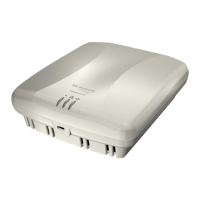
Do you have a question about the HP ProCurve MSM410 and is the answer not in the manual?
| Type | Wireless Access Point |
|---|---|
| Frequency Bands | 2.4 GHz, 5 GHz |
| Maximum Data Rate | 300 Mbps |
| Ethernet Ports | 1 x 10/100/1000Base-T |
| Antenna Type | Internal |
| Frequency band | 2.4 GHz, 5 GHz |
| Modulation | OFDM, DSSS |
| Operating relative humidity (H-H) | 10% to 90% (non-condensing) |
| Wireless Standards | IEEE 802.11a/b/g |
| PoE Support | Yes (802.3af) |
| Ethernet LAN data rates | 10, 100, 1000 Mbit/s |
| Networking standards | IEEE 802.11a, IEEE 802.11b, IEEE 802.11g |
| Security algorithms | WEP, WPA, WPA2 |
| Input voltage | 48 V |
| Operating temperature (T-T) | 0°C to 50°C |
| Management | Web-based, SNMP |
| Model | HP ProCurve MSM410 |
Lists the items included in the product package, such as the access point, mounting bracket, and screws.
Details the available ports, including Ethernet and Console ports, and their functionalities.
Describes the integrated wireless radio and antenna specifications of the access point.
Explains how to use the reset button for device reset or factory default restoration.
Compares the operational differences between controlled and autonomous modes.
Details status light indicators during startup and discovery in controlled mode.
Explains status light indicators for power, Ethernet, and radio in autonomous mode.
Covers professional installation requirements, cabling, country selection, safety, and powering.
Provides instructions for mounting the bracket directly on a wall or to an electrical box.
Details how to attach the bracket to a suspended ceiling T-bar.
Explains how to connect the Ethernet cable and secure the access point to the mounted bracket.
Guides through switching to autonomous mode and performing initial setup via web browser.
Details the login process, license agreement, registration, and password changes.
Explains how to reserve an IP address via DHCP server or assign a static IP address.
Guides on connecting a computer wirelessly and testing Internet access.
Describes how to clear wireless security filters to allow access to additional network resources.
